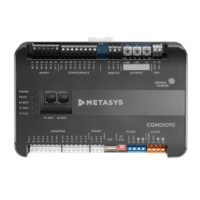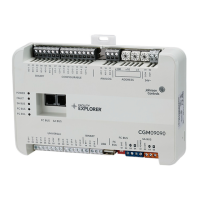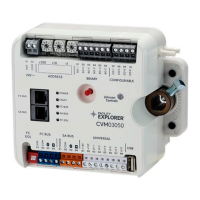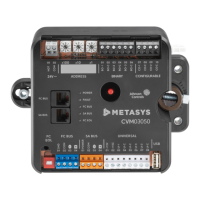Physical features
The following figure displays the physical features of
the CGM09090 and the CGM04060 controllers, and the
accompanying table provides a description of the physical
features and a reference to further information where
required.
Figure 1: CGM Physical Features (CGM09090 model
shown)
Table 1: Physical features of CGM controllers
Physical Feature: Description and References
1
Binary Outputs (BO) Terminal Block: Black terminals. See
Table 3.
2
Configurable Outputs (CO) Terminal Block: Black
terminals. See Table 3.
3
Analog Output (AO) Terminal Block: Black terminals. Only
present on CGM09090 model. See Table 3.
4
Device Address Rotary Switch Block: Decimal Addressing.
See Setting the device address.
5
Supply Power Terminal Block: Gray terminals; 24 VAC,
Class 2. See Supply power terminal block)
6
Cover Lift Tab. See Removing the controller cover
7
Sensor Actuator (SA) Bus Terminal Block: Orange terminal.
See SA bus terminal block
8
Field Controller (FC) Bus Terminal Block: Blue terminal.
See FC bus terminal block (or N2 protocol as required))
9
End-of-Line (EOL) Switch. See Setting the End-of-Line
(EOL) switch)
10
Universal Serial Bus (USB) 2.0 host type A Port
Note: The USB feature is not currently supported.
11
Binary Input (BI) Terminal Block: White terminals. See
Table 3)
12
Universal Inputs (UI) Terminal Block: White terminals. See
Table 3)
13 FC Bus Port RJ-12 6-pin Modular Jack (see FC bus port)
14 LED Status Indicators (see Table 10)
15
Sensor (SA Bus) Port: RJ-12 6-Pin Modular Jack (see SA Bus
port)
Mounting
Observe the following guidelines when mounting a
controller:
• Ensure the mounting surface can support the
controller, DIN rail, and any user-supplied enclosure.
• Mount the controller horizontally on 35 mm DIN rail
whenever possible.
• Mount the controller in the proper mounting position.
• Mount the controller on a hard, even surface whenever
possible in wall-mount applications.
• Use shims or washers to mount the controller securely
and evenly on the mounting surface.
• Mount the controller in an area free of corrosive vapors
and observe the Ambient Conditions requirements in
Table 13.
• Provide for sufficient space around the controller for
cable and wire connections for easy cover removal
and good ventilation through the controller (50 mm
[2 in.] minimum on the top, bottom, and front of the
controller).
• Do not mount the controller on surfaces prone to
vibration, such as ductwork.
• Do not mount the controller in areas where
electromagnetic emissions from other devices or wiring
can interfere with controller communication.
On panel or enclosure mount applications, observe the
following additional guidelines:
• Mount the controller so that the enclosure walls do
not obstruct cover removal or ventilation through the
controller.
• Mount the controller so that the power transformer
and other devices do not radiate excessive heat to the
controller.
• Do not install the controller in an airtight enclosure.
Figure 2: Controller mounting position
M4-CGM General Purpose Application Controller Installation Guide2
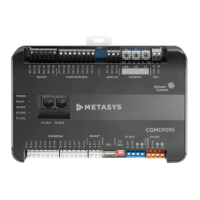
